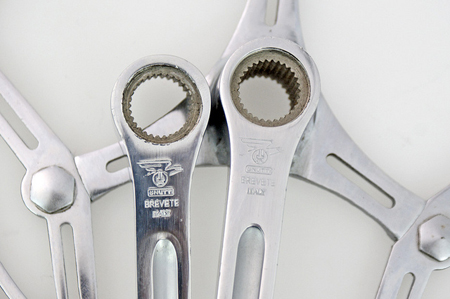Fine Italian Steel
 Mon, March 21, 2016
Mon, March 21, 2016 
On hearing the term “Fine Italian Steel,” one usually thinks of handcrafted steel frames, but in the early 1950s, Italy having made a quick recovery from the devastation of WWII, were producing some quite beautiful steel bicycle components.
There were no Campagnolo Groupos in the early 1950s, Campagnolo made quick release hubs and derailleur gears, and that was it. Pedals and cranksets were introduced in the late 50s.
The two main brands I remember were Gnutti and Magistroni, between them they made cranksets, bottom bracket bearings, hubs and headsets.

Gnutti made a really elegant cotterless crankset, (Pictured above.) that fitted onto a tapered and splined BB spindle, and was held in place with recessed Alen screws.
 They also made a less expensive cottered crank, which was the one I used, pictured left.
They also made a less expensive cottered crank, which was the one I used, pictured left.
Both Gnutti and Magistroni cranks were a three arm pattern with the same standard bolt circle diameter.
They were often used in conjunction with the French made Simplex chainrings.
Simplex had these three simple bolt-on adapter arms. (Picture below.)
 Gnutti’s quick release hubs were a copy of Tulio Campagnolo’s original idea, I’m not sure if the patent had run out, or they were made under license. The hubs had a chromed steel barrel with aluminum flanges pressed and swaged into place. (Pictures below.)
Gnutti’s quick release hubs were a copy of Tulio Campagnolo’s original idea, I’m not sure if the patent had run out, or they were made under license. The hubs had a chromed steel barrel with aluminum flanges pressed and swaged into place. (Pictures below.)
 Finally this Magistroni headset (Pictured below right.) intrigues me, it is quite an engineering masterpiece. How did they get the “Magistroni” name around its circumference?
Finally this Magistroni headset (Pictured below right.) intrigues me, it is quite an engineering masterpiece. How did they get the “Magistroni” name around its circumference?
 It would not have been cast, a casting would not work as a bearing surface.
It would not have been cast, a casting would not work as a bearing surface.
Stamping not possible around the complete circle. It would not have been engraved or pantographed, too costly.
Knowing a little about engineering practices of that era, I believe the lettering was rolled on.
Probably done while the bar stock was in a solid piece, before the headset cup was shaped in a lathe. The bar would be turned slowly and a rotating die with the lettering in reverse pressed into it under great pressure. If anyone else has any alternative theories let me know.
Also note the teeth machined into the top of the bearing cup, with a lock ring with matching teeth. After loosening the top nut, this would allow adjustment by hand, one notch at a time. The lock ring being keyed to the steering tube would prevent the bearing cup from turning as the top nut was re-tightened.
 Dave Moulton | Comments Off |
Dave Moulton | Comments Off | 

















Reader Comments (7)
I have just spoken to someone much more knowledgeable than me, (MSc in mechanical engineering) he is of the opinion it is hot forged into a split die and machined then heat treated afterwards. The forging also gets the grain structure to flow and give additional strength.
On my 1958 Bianchi Specialissima the top and bottom lugs have the headset races pressed into them. Think about replacing those...only they didn’t need to be, unlike the Campy HS of the 70's & 80’s, which pitted after only a few months.
So many things manufactured without NC or CNC would be impossible to do today without computer controls, as those machines of lore are almost gone, except Swiss-Screw cam machines (Also certain gun-drilling machines still in use, to name a few), which still cannot be beat by CNC lathes. What's near-extinct are Swiss-Screw machinists, or the people to run them.
We can’t go back, but too bad consensus views the “old days” so negatively. Hell, we went to the moon without CNC machines and CAD/CAM, yet haven’t been back with them!
That splined Gnutti crankset is very cool! I had never seen one before now.
Fine Italian Steel implies a good start for making something. I was wondering what happened to Masi USA. You, Dave, along with Jim Allen, Jim Cunningham, Mario Confente, Brian Baylis, Dave Tesch, seems like a Dream Team for such an icon as Falierio Masi!
Also seems it didn’t last as long as Fine Italian Steel.
The top race was probably investment cast. That much relief and fine details of the background hatching right next to the raised lettering wouldn't be possible with any sort of rolling on a lathe. Forging, as Peter suggested would certainly be possible for less detailed lettering, but I would be surprised if you could get that kind of detail to hold up in a hot forging die. The only real downside to cast steel would be brittleness compared to forged steel, but the top race doesn't see anywhere near the loads the lower races see.
I have been a Porsche owner now since 1966 The wheels on my 1970 911T that I purchased new and still have. are FORGED alloy. Called the S type wheels. I have often wondered about this FORGED type and not cast wheel?
Thankyou for the wonderful memory, I raced a set of Magistroni fluted cottered cranks on my Merlin 531 road machine as a keen young lad in the 1960's here in NewZealand, still have the frameset but regretably the components are long gone.